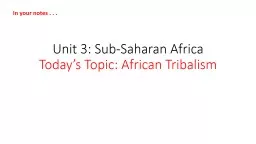

Todays Topic African Tribalism In your notes Common Origin of Tribes The Bantu Test Question The Bantu Migration Bantu originally came from Equatorial Africa Over thousands of years Bantu ID: 815299
Download The PPT/PDF document "Unit 3: Sub-Saharan Africa" is the property of its rightful owner. Permission is granted to download and print the materials on this web site for personal, non-commercial use only, and to display it on your personal computer provided you do not modify the materials and that you retain all copyright notices contained in the materials. By downloading content from our website, you accept the terms of this agreement.
Slide1
Unit 3: Sub-Saharan AfricaToday’s Topic: African Tribalism
In your notes . . .
Slide2Common Origin of Tribes: The BantuTest Question
Slide3The Bantu Migration
Bantu originally came from Equatorial Africa.
Over thousands of years, Bantu
people migrated south from West
Africa.
Today, most Sub-Saharan black Africans have some connection to the Bantu
people: language, religion, customs, etc.
Slide4African Tribalism
There are several questions on the different aspects of Tribalism and the effects on the test!
Slide5Common Traits or Characteristics of Traditional African Tribal Life
The good of the group comes ahead of the good
of the individual.
All land is owned by the group.
Strong feeling of loyalty to the group.
Important ceremonies at different parts of a
person’s life.
Special age and work associations.
Deep respect for ancestors.
Religion is an important part of everyday life.
Government is in the hands of the chiefs [kings].
Slide6Family & Lineage
Most tribes are structured around the extended family
parents, children, grandparents . . .
Lived in small villages
Families were combined into larger communities known as lineage
groups/clans
Your lineage says a lot about your place in
society.Extended family has struggled as many rural Africans have begun moving to cities – urbanization.
Tribes are either patrilineal or matrilineal (trace heritage through father or mother’s family).In many tribes, women make the important decisions.
Slide7Traditional Societies: Family Descent
Patrilineal
trace ancestors through fathers
Matrilineal
trace ancestors through mothers20% of African societies are matrilineal today
Slide8Specific Duties
Loyalty to family, age-sets helped village members work together
Men hunted, farmed; women cared for children, farmed, did domestic chores
Even very old, very young had own tasks; elders often taught traditions to younger generations
Age-Sets
In some areas, people took part in type of group called age-sets
Men who had been born within same two, three years formed special bonds
Men in same age-set had duty to help each other
Social Structures
Slide9Community & Education
The group is more important than the individual.
Age Sets: Based on one’s age, a tribesperson has different responsibilities.
Men: hunt, protect, farm
Women: raise children, prepare food, clean
Different villages had different methods of raising and educating
children:
Congo – boys and girls were raised by mom until age 6. Learned language, family history,
songs, etc.After that they were separated, girls to the “house of women” and boys to the “house of men”Traditions are handed down orally from generation to generation.Griots of West Africa serve as storytellers using poetry, dance, and rhythm to pass on history.
Slide10Role of Griots
Slide11Griots of West Africa
Slide12Griots, pronounced "greeohs", are storytellers of West Africa who use poetry and rhythm to teach villagers about their history. Their home is the territory of the Mandinke people in the country of Mali where their tradition is alive to this day.
"Griot" is the French term for this class of musicians; the local term is jeli.
Slide13Music and Dance
In many societies, music, dance central to many celebrations, rituals
Carving, wearing of elaborate masks part of these rituals as well
Early Africans excelled in sculpture, bronze as well as terra cotta
Traditional music performed with variety of wind, stringed instruments
Griots
Many early societies did not develop systems of writing
Maintained sense of identity, continuity through oral traditions
Included stories, songs, poems, proverbs
Task of remembering, passing on entrusted to storytellers,
griots
Slide14Griots: Oral Storytelling
Tradition passed down by storytelling
Two forms of tales
Human characters
Animal characters
Human tales dealt with creation, death, success & love
Animal tales focused on small creatures vs. larger beasts
Slide15Problems of Tribalism Today
Slide16Problems of Tribalism Today
1.
The tribe is more important than the nation.
2.
Communication problems.
3.
Inter-tribal warfare
civil wars.
4.
Tribal favorites for government jobs:
Nepotism
Urbanization:
Breaks down tribal traditions.
Tribal intermingling on
the job.
Slide1717
Globalization & Diversity: Rowntree, Lewis, Price, Wyckoff
Tribalism problem
Tribalism is often a stronger force than nationalism.
Political parties based on tribes
Problem of creating nationalism artificially.